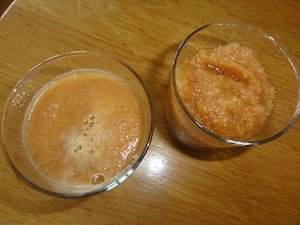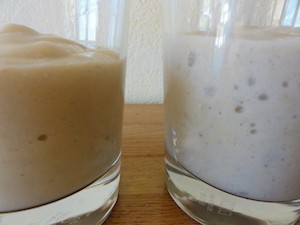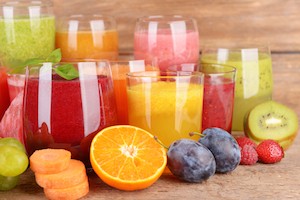Benefits and disadvantages of juices and smoothies
The advantages of juices and smoothies for health are numerous. Dr. Sears says: “Juicing is a process which extracts water and nutrients from produce and discards all the fiber. Without all the fiber, your digestive system doesn’t have to work as hard to break down the food and absorb the nutrients. This is especially helpful if you have a sensitive digestive system or illness that inhibits your body from processing fiber. The fiber in produce helps slow down the digestive process and provides a steady release of nutrients into the blood stream. When you remove the fiber from the produce, the liquid juice is absorbed into your blood stream all at once causing a spike in blood sugar. Unstable blood sugar levels can lead to mood swings, energy loss, memory problems and more! Fiber is also filling, and without fiber in the juice, you will be hungry again quickly.
Blending is the process of finely chopping up the entire fruit or vegetable, skin and all, to produce a smooth consistency. Blending produce leaves all the fiber in the mixture, which helps create a slow, even release of nutrients into the blood stream and avoids blood sugar spikes.”
On FoodMatters.com, it is stated that: “Freshly squeezed vegetable juices form part of most healing and detoxification programs because they are so nutrient rich and nourish and restore the body at a cellular level.”
In the GAPS diet, Dr. Campbell-McBride says “Freshly pressed fruit and vegetable juices are highly recommended. They will speed up the detoxification processes in the body and support the liver”.
Other virtues of having juices and smoothies is to be able to consume more vegetables than you normally would. Also, combined with sweet vegetables or fruits, it is possible to eat more bitter-tasting vegetables.
So for people who don’t like the texture of vegetables, such as in the case of some children, juicing and blending can be a good way to include vegetables in the diet.
These are the good news. The bad news is that during the process of juice extraction and blending a significant part of the nutrients are destroyed.
The oxidation process
Dr. Brian Clement, director of the Hippocrates health Institute, states that blending destroys a large amount of nutrients in a smoothie. The explanation is that the oxidation caused by oxygen being sucked into the blender destroys the nutrients.
Oxidation occurs when any food is juiced, cut, chopped, shredded, peeled, chewed, dehydrated and then exposed to air. This is because the cell walls are broken and the cell contents are exposed to the oxygen. Vitamins, minerals and proteins chemically combine with the oxygen and are rendered unusable to us in providing the nutrition they’re supposed to.
The oxidation can be seen in some food for the brown color, for example in apple, although in some food there isn’t any change of color.
There is some controversy about the amount of loss of nutrients when juicing and other kind of food processing. In order to minimize this loss, it is better to use a cold pressed juicer.
In www.coldpressedjuicer.com s stated that “A cold pressed juicer does better on both accounts (taste and nutritional content) because it avoids the oxidation reactions caused by fast moving centrifugal juicers. The fast moving blades do two things: 1) they move quickly thus ‘stirring’ more oxygen into your juice, 2) they heat things up. Heat causes chemical reactions to occur faster, and more oxygen can mean more oxidation reactions” … “A cold pressed juicer avoids oxidation by slowly crushing your produce rather than rapidly chopping it up. This minimizes the ability for oxidation reactions to happen – and thus conserves your nutrients for you and your juice. Drinking your juice soon after you’ve made it will also help reduce oxidization and ensure you are drinking the freshest, healthiest juice around!”
Some experiments
It seems also that blending causes less oxidation than juicing. In www.incrediblesmoothies.com is given as proof of this fact. “Victoria Boutenko conducted an experiment on potatoes where she juiced one and blended the other. After two days, the blended potato had very little oxidation, most of which was at the top of the glass where the liquid was exposed to air. The juiced potato turned brown and oxidized much more rapidly.”
I wanted to find out if there’s any difference in terms of oxidation between juicing and blending. So I tried it with an apple. And this was the result:

As you can see, the brown color indicating oxidation is the same in both cases.
Also, it is said (for example in Sweetnaturalliving) that by using a stick blender (or hand mixer) less oxidation is produced, because there it avoids the vortex such as the one that appears in regular blending machines. The vortex sucks air into the smoothie and exposes food to a greater amount of oxygen and oxidizes it.

The result was positive, the stick blender is slightly better than regular blenders.
Even better: whole produce
There is not doubt of the benefits of juices and smoothies. But it is even better to eat fruits and vegetables in their whole state. For example, if you bite an apple, the amount of oxidation is reduced to the small surface that will be exposed to the air during the short time between every bite.
Furthermore, ingesting a huge amount of fruits or vegetables, as juices and smoothies allow to do, is not a natural way of eating. Eating the nutrients of a juice of 4 carrots all in a sudden could result in a shock for the organism to handle such amount of concentrated nutrients.
And even if in a smoothie we eat the whole product, fiber included, we are skipping the first step of digestion: the action of saliva, which contains a large amount of enzymes to digest carbohydrates. So all the carbohydrates contained in the food will not be digested well in smoothies.
T.C.Fry states on “The Life Science Health” that “Shredding, which produces a greater number of exposed surfaces, is obviously more destructive than cutting up. Grinding is even worse, producing smaller particles. Blending breaks the food down even more, and juicing extracts only the juice, discarding all the fiber.
All these processes deprive the body of part or all of the chewing exercise, which is necessary for the secretion of salivary enzymes and for sending signals for the secretion of gastric digestive juices.
In addition, vital food elements are impaired or destroyed. Oxidation of food is intended to occur within the body, and when it is allowed to occur before the food is eaten, the body is deprived of important elements. Blending, grinding and shredding cause significant losses of Vitamin C as the fragmented foods are exposed to the air, and as much as a 50% loss of Vitamin C within a few minutes after food is juiced
This is one of the dangers of drinking extracted juices. They are so concentrated that it is easy to overload the body with one nutrient or the other. If juices are actively desired, then they should be made fresh, consumed immediately, and used only in the same quantities that you would eat them. For instance, it is quite possible to “drink” twenty or more carrots in a couple glasses of carrot juice. We’re not equipped to handle twenty carrots given to the body in such a short time. It would be better if two or three carrots were juiced and then sipped slowly.
Less Is Better: The less preparation to which foods have been subjected, the better nourishment they provide”
Conclusion
Juices and smoothies are a very good option for children and people who do not enjoy fruit and vegetables too much, or people with dental issues who cannot bite their food. In this case, be careful not to overload your drink with a great amount of fruit and vegetables, make the juice or smoothie from the same amount that you would normally eat if it were in its whole state.
Home-made juice and iced juice lollies may also be an occasional treat.
But keep in mind that it is always much better to eat vegetables and fruits in their whole natural state!
Thank you to my daughter Judit for the English correction.
 Juicing and blending vegetables and fruits is recommended in several diets. Some of them, such as Gerson therapy, rely almost exclusively on this kind of food. They advocate that it’s the best way for detoxifying the body, as well as providing a lot of important nutrients.
Juicing and blending vegetables and fruits is recommended in several diets. Some of them, such as Gerson therapy, rely almost exclusively on this kind of food. They advocate that it’s the best way for detoxifying the body, as well as providing a lot of important nutrients.











